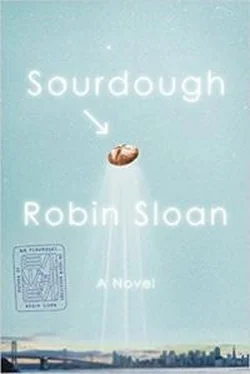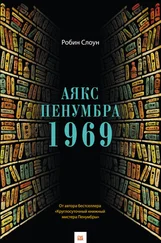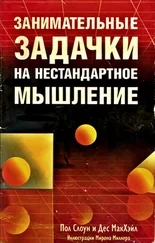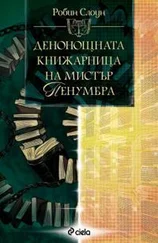This time, I pressed ahead.
They lived in row houses made from corrugated cardboard and superfine netting. I saw them milling around, climbing on top of one another, jumping and flickering, chittering and chirping.
What were the epic sagas of the cricket kingdom?
From back in the concourse, I heard a low and commanding chime.
HUNGER
LATER THAT MORNING, with the first light of day peeking in through the skylight above the lemon grove, I was forming one set of loaves while the arm mixed a batch of dough when Jaina Mitra appeared, fully suited up in her lab coat again.
I curled my face into the beginning of an apology, but she held up a hand preemptively. “I’m not angry,” she said. “Well, I am. You should have just accepted my offer and let me help you. But it doesn’t matter.”
I stood there with a cold lump of dough in my hands. “Is that all, then?”
Jaina Mitra’s nostrils flared. “Not by a long shot.” The slashes under her eyes seemed darker than usual. She tossed a printout onto the countertop. “I’ve never seen anything like it.”
I recognized the spiky cascade from the screen attached to the sequencer; it was exactly what I’d seen in the middle of the night, found inscrutable, emailed to myself, and, after reviewing it in the morning, still found inscrutable. This printout was wildly annotated in bright green ink—little blobs and whorls and, above the graph, an exclamation in Jaina Mitra’s blocky handwriting: WOW!
“Listen to what I’m saying,” she said. “Sourdough starter is a community of organisms. You know that, right?”
“Yes. Of course.” Everett Broom taught me that.
“Generally, there are two or three different species living together. That’s what they say at the bread lab.”
“There’s a bread lab?”
“Washington State. They do very good work. Maybe four species can live together in a stable community. But this is the sequencer’s report on your starter. You saw this?” I nodded, and Jaina Mitra snorted lightly. “I almost cried.”
She smoothed the printout flat on the countertop and pulled a green-barreled pen from her lab coat.
“This here”—she indicated the graph’s broadest peak with the pen’s tip—“this is the yeast. And this”—she indicated another peak—“is Lactobacillus sanfranciscensis .” She pronounced it carefully. “These—” She danced the tip of her pen along a series of sharper spikes. “These are matches for bacteria in the Global Microbiome Survey. It adds up to a lot more than four, obviously.” Then she traced a wide box around the series of spikes that rippled along the graph’s floor. “And these—there are so many of them—these are novel.” She raised both eyebrows.
Apparently that did not impress me as much as it should have.
“ Meaning ,” she went on, “there are no matches in the library. That, by itself, isn’t so strange; like I told you, my cabinet is full of novel organisms. What’s strange is finding this many taxa, known and unknown, living together in an apparently stable community.” She paused. Looked at me. Over at my workstation. Back at me. “It is stable, isn’t it?”
It felt like she was asking about me, not the starter. “I’ve been baking with this starter for months. I got it from a baker who had it for—years? Yes, it’s stable.”
She tsked. It was a tsk of awe. “There must be a hundred constituents! The smallest spikes might be noise—it’s hard to tell. But even so, this many! It’s a scale and complexity of commensal behavior beyond anything I’ve ever seen or read about.” Jaina Mitra looked like she wanted to shake me. “It is unreal .”
* * *
WE SAT WITH OUR ESPRESSO CUPS beneath the lemon trees and I told her the starter’s story. Jaina Mitra did not make a good audience; her gaze was hard and hungry, and she scrawled notes as I spoke, page after page of them in green ink. She made me nervous.
I finished by explaining the starter’s decline, my consultation with Stephen Agrippa, its resurgence, and my concern that I’d taken it too far. Because I didn’t understand what I was working with.
Jaina Mitra stared down at her notes. “Everyone in my field is obsessed with identifying new organisms,” she murmured. “It’s like a treasure hunt. But I already have the organisms I need. I just can’t put them together.” She looked up, staring into space. “How do their communities work? I try…” She sighed raggedly. “When I move one piece, the others don’t fit anymore. When I turn one knob, the other knobs eat it for dinner. My new batch is worse than ever. Do you know what makes it so sticky? It’s not the enzymes. It’s what the enzymes produce . Dead cells. Lysed bacteria. Corpses!”
The gluey taste of death. Great.
Jaina Mitra was showing me something real, and it ran a little ragged, and it made me like her a little more. Like, two percent more.
She laid her hands flat on her notebook. “I’d like to study your starter.”
“I don’t think it’s going to solve your problem.” I said it as lightly as I could.
Her face was a mask of control. “It might. Please. We could work together.” She was suddenly sweet and solicitous, and it was very strange. She should have stayed sharp and brusque. She should have commanded: Let me work with that muck of yours! I would have complied in a moment.
THE SLURRY FACTORY
IT WAS THE DAY BEFORE the Marrow Fair’s grand opening, and I was relaxing at my workstation, satisfied with my ability to produce enough sourdough, wasting time on the internet, and still thinking about Jaina Mitra’s offer when she appeared again to announce she wanted to show me something that could, or should, influence my decision. It involved a car trip, and could I take the afternoon off? I accepted. I had the feeling, suddenly, that I’d been down in the darkness of the depot for too long.
A year in California and I’d rarely been south of Daly City, never stepped foot in San Jose, and barely contemplated the existence of the San Joaquin Valley.
Driving down California State Route 99 in the passenger seat of Jaina Mitra’s blue Tesla, the rightmost lane was taken up completely by semis hauling trailers, and beyond them endless orchards, silvery olive trees alternating with spiky almond trees, solid green to the horizon. The San Joaquin Valley’s existence was confirmed.
We watched a pickup truck with a portable toilet in its bed crawling along an access road, keeping pace with the pickers who were sweeping across the field in a loose line.
There were structures that poked out in places: immense, featureless white warehouses, like big-box stores before any branding had been applied. We saw grain elevators, smelled feedlots.
Jaina Mitra eased onto an exit ramp and turned onto a long, straight road called Avenue 16. We passed a neon-green tractor lumbering on the shoulder and I waved to its driver, who waved back. Farther up, we watched a small plane fly in low arcs over a vast field of pistachio trees, leaving a trail of pink vapor. I fumbled with the Tesla’s control panel and set the AC to recirculate.
We turned off Avenue 16 onto Road 23. There were too many long, straight roads out here to bother with names.
A semi was rattling up the road, coming in the opposite direction. The trailer it hauled was painted bright green, and as it passed, I saw a familiar logotype rendered in crisp white. That semi was hauling nutritive gel.
This was Slurry country.
The facility was ahead. It was enormous, one mile square, a tangle of towering vats with pipes and valves embroidering their surfaces, all of it bounded by loading docks where more bright green trailers were waiting. Train tracks ran straight through the facility; Slurry could be lowered in containers directly onto freight cars and hauled away to Chicago or New York or the Port of Oakland and points beyond.
Читать дальше










